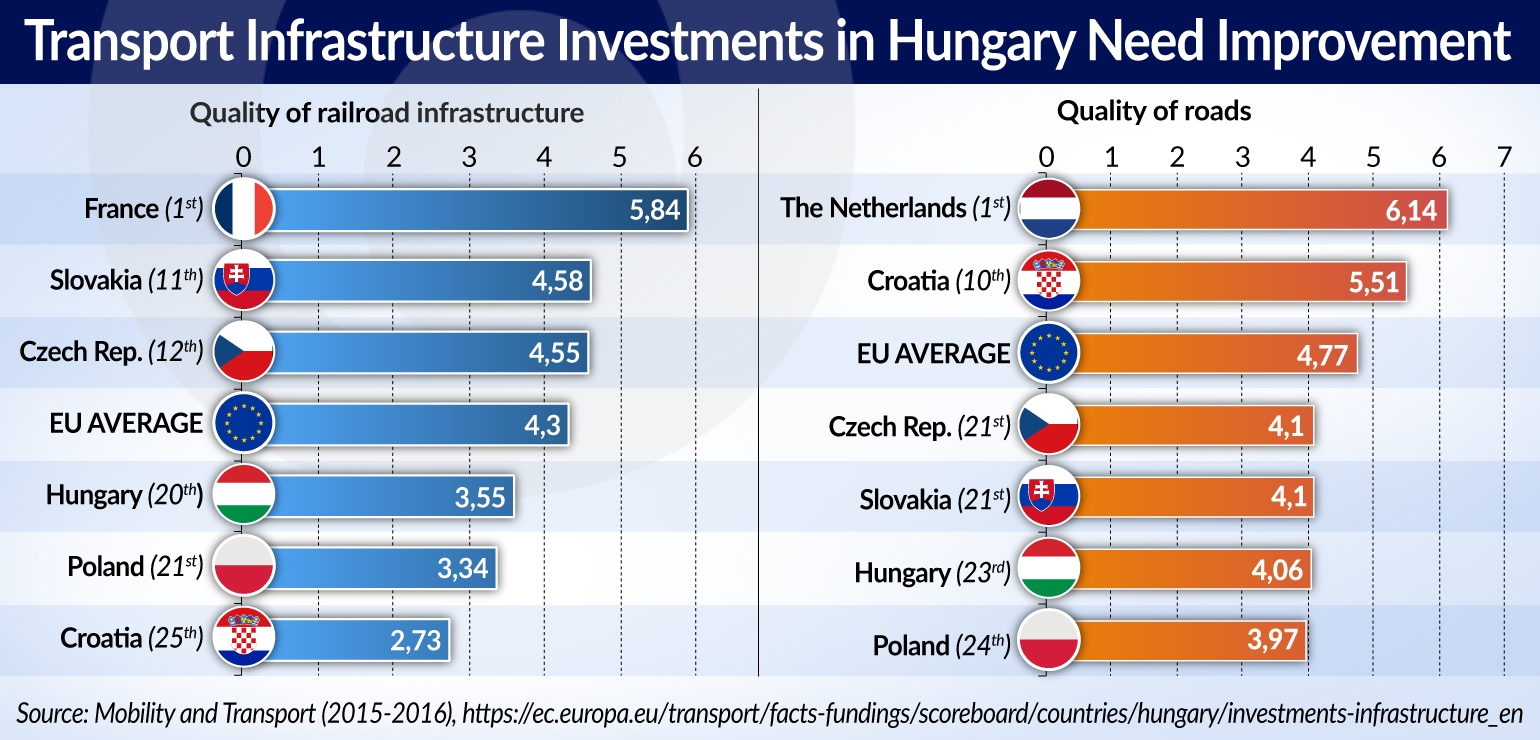Tydzień w gospodarce
Category: Trendy gospodarcze

In 2010, Viktor Orbán’s Fidesz party regained power in the country after being in the opposition to the left-liberal government for eight years. Although, the country was in deep economic crisis, among the countries of Central and Southeast Europe Hungary distinguished itself by having a relatively well-developed infrastructure – especially if we consider the Hungarian system of highways and motorways. Budapest, the capital city has been already connected with most of the largest cities in Hungary, like Debrecen, Szeged, Pécs, Székesfehérvár, or Győr, as most of Hungary’s neighboring states.
By the end of 2010, the Hungarian motorway system consisted of 1,290 km of roads, whereas by the end of 2016 it was almost 1,481 km, with the country’s area of 93,030 square kilometers. By 2022, the Hungarian government intends to build or finish roads with the total length of almost 380 km. Particularly worthy of attention are the plans to extend the M30 motorway by 60 additional km, which will be built between Miskolc and Tornyosnémeti, a small town on the border with Slovakia.
This motorway will connect the M3 motorway, which runs from Budapest towards the Ukrainian border, near the city of Miskolc, will meet with the Slovak R4 expressway, as a part of the European route E71, which will finally connect the Croatian city of Split on the coast of the Adriatic Sea with Košice in Slovakia. What is more, in the future it may be extended into Eastern Poland, as far as the city of Rzeszów; such plans were announced during a meeting between the Polish and Hungarian Prime Ministers in 2016. If the plan is carried out, it could successfully stimulate trade between countries of the Three Seas Initiative. Of course, only if this idea will be not limited to declarations.
Whereas in ancient times of the Roman Empire all roads led to Rome, in Hungary all motorways seem to lead to Budapest, which is partly justified by the fact that about 1/5 of the population of Hungary lives in its capital. But, in spite of good motorway connections with Budapest, there is a noticeable lack of motorway or expressway connections between such cities as Debrecen and Szeged, or Pécs and Szeged.
However, while the Hungarians may complain about the insufficient length of motorways, they must really be disappointed with railway connections between the largest cities, naturally with the exception of connections with Budapest. For instance, Pécs and Szeged are the two most important cities in Southern Hungary, located at a distance of about 180 km from one another. If somebody decides to go from Szeged to Pécs by train, the journey will take over six and half hours, obviously with a transfer in Budapest.
At the same time, Budapest is the only Hungarian city with a metro system, and in fact the only city in Hungary, which needs a metro. Budapest metro is made up of four lines. In 2014, Line 4 (M4), connecting the Budapest Keleti Railway Station with Kelenföld Railway Station (District XI in Buda), and running under the Danube, was opened. Line 4 has 10 stations and the length of 7.4 km. The Budapest Metro lines have a total of 52 stations and the length of 38.6 km. It should be emphasized that the construction of Line 4 began in 2006, so it took 8 years to complete 10 stations. No further stations are currently under construction, and the plans of future extensions seem very vague.
However, the underground system in the Hungarian capital will for years remain a model for other capitals in CSE, especially for Warsaw (with only 2 lines, the second still under construction) or Belgrade (with no metro at all).
The project of Line 4 was met with criticism and many allegations, including those of political nature. The Line 4 was criticized for was its route, which follows the routes of many trams and buses, therefore making it redundant. On the other hand, Line 4 connects two out of the three most important railway stations in Budapest (Keleti and Kelenföld), allowing the passengers to reach the other of the two stations in 15 minutes. Last but not least, the line was opened by Prime Minister Viktor Orbán in March 2014, few days before the parliamentary elections. The construction of Line 4 cost EUR1.5bn, partially financed by the EU, but one of the world’s most expensive metro lines.
Hungary is not actually much different from other countries in CSE when it comes to transport infrastructure. According to the ratings of the quality of transport infrastructure compiled by World Economic Forum, Hungary is definitely below the EU average considering all means of transport. The best quality of railroad infrastructure is that of France, with the index at 5.84 (the EU Average is 4.30). Hungary scores 3.55, which is the 20th result among countries of the European Union, one position ahead of Poland (3.34) and five positions ahead of Croatia (2.73). Slovakia and the Czech Republic, on the other hand, have much better railroad infrastructure than Hungary (4.58 and 4.55 respectively).
Hungary is also definitely ranked well below the EU average in rating of the quality of roads, with indicator of 3.55 (23rd position). Among countries of Visegrad Group plus Croatia, only Poland is on a worse position (24th with 3.97). Meanwhile, the Czech Republic and Slovakia are both ranked as the 21st position, with indicator of 4.10. Quite surprisingly, Croatia is the 10th country in the EU with the best quality of roads (5.51), ahead of Sweden, United Kingdom, and Ireland.
Taking all this into account, it is obvious that in spite of good macroeconomic results Hungary achieved after years of Fidesz in power, an increase in Hungarian transport infrastructure investments is urgently required, especially outside the capital. If this issue is solved, it can accelerate further growth of the Hungarian economy.
Michał Kowalczyk is a PhD student at the History and Social Science Department of the Cardinal Stefan Wyszyński University in Warsaw. He specializes in Hungarian and Central European politics.

